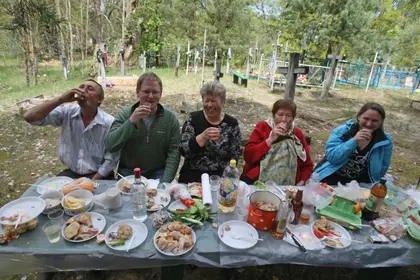Halloween, one of the most popular holidays in the United States, celebrated on the night of Oct. 31, has been gaining popularity among Ukrainians. The local partygoers like its carnival element and gladly put on various costumes: from ancient nobility or cartoon characters to the costumes of evil spirits, demons and vampires.
However, this masquerade not only hides the ancient Celtic meaning of the Halloween holiday but also alienates Ukrainians from their own traditions and cultural roots.
JOIN US ON TELEGRAM
Follow our coverage of the war on the @Kyivpost_official.
Lada Luzina, a Ukrainian writer and a researcher of Ukrainian legends and traditions, regrets that Ukrainians neither value nor promote their own traditions.
“If within the walls of the Ukrainian Ministry of Culture there is a single person that really knows the history of Ukrainian holidays and traditions and at the same time knows PR techniques, he would perfectly use the energy of Halloween to evoke the general interest towards these mystical days in order to revive the Ukrainian Didy,” Luzina wrote in her blog for Segodnya newspaper.
Didy (Grandfathers), Ukrainian Memorial Days, fall on the late October – early November period. Ethnographer Olena Chebaniuk says that in Ukraine there are several traditional commemoration days in fall – St. Lukas on Oct. 31, St. Kosmy and Damyana on Nov. 14 and St. Mykhaylo on Nov. 21. Yet the most famous commemoration is called “Batkiv’ska Subota” (Father’s Saturday) and is celebrated according to the Orthodox Church calendar on the closest Saturday before Nov. 8, the St. Dmytro Day.
Ukrainians used to believe that the dead could significantly influence their lives. During the commemoration period people visit their relatives’ graves and leave food there to cajole the dead.
In the past, women used to bake pies, rolls, and distributed them among the poor – it was believed that the ancestors often come back on the Memorial Day under the masks of poor and orphaned, ethnographers say. Ukrainians believed that during this mystical period the dead may visit their living relatives at their homes.
“Late October – beginning of November – is the transitional period between the seasons when the earth bears fruits and when the earth rests. Many nations believed it is the time when the border between the word of dead and alive disappears,” Chebaniuk says.
Halloween, the evening before the Christian All Saints Day or All Hallows Day, preserves the features of the ancient Celtic holiday of Samhain. Samhain was the holiday that marked the end of summer and the beginning of winter. Celts believed that on the night of Oct. 31 the ghosts and dead returned to the earth so people lit bonfires and wore costumes to ward off the roaming ghosts.
“Symbolically the Slavic ritual of feeding the souls of the dead relatives is not much different from the Halloween ritual when evil spirits from the other world come to the house with a ‘trick or treat’ ultimatum,” Luzina writes. “These masquerades are the souls of the dead, successfully used by pop culture.”
You can also highlight the text and press Ctrl + Enter




